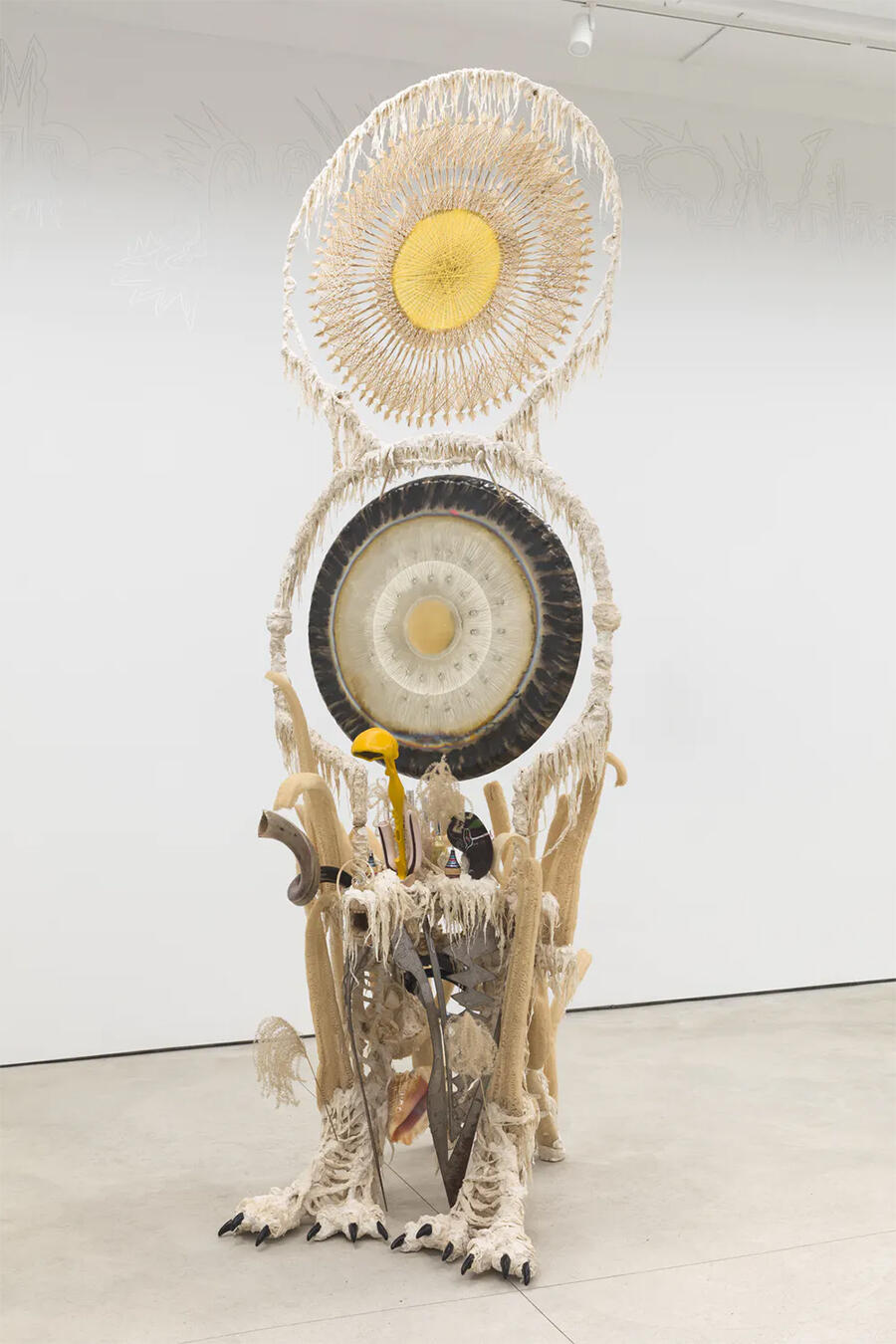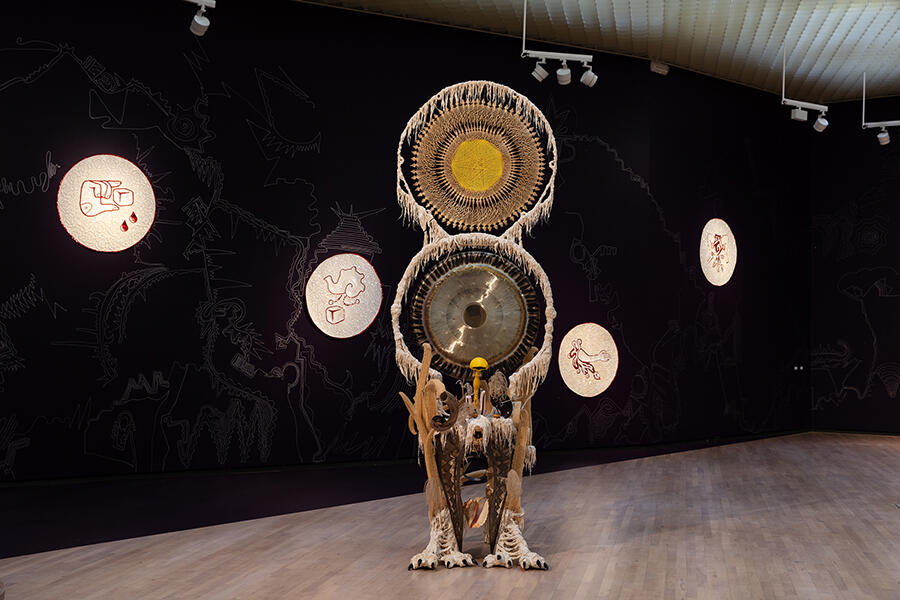Guadalupe Maravilla Is Making Space for Healing
The Salvadoran artist talks to Aruna D’Souza about retracing his childhood migration through Central America and Mexico, collectively healing trauma and performing in the dark
The Salvadoran artist talks to Aruna D’Souza about retracing his childhood migration through Central America and Mexico, collectively healing trauma and performing in the dark

In March, Guadalupe Maravilla’s first solo exhibition in Europe, ‘Sound Bótanica’, opened at the Henie Onstad museum in Norway, where he was presented with the 2021 Lise Wilhelmsen Art Award. The show gathers four major series of Maravilla’s work. The ‘Disease Throwers’ sculptures (2019–ongoing) created using objects gathered during the trips on which the artist retraced the harrowing journey he made alone to the US at the age of eight to escape the war in El Salvador. These works also incorporate aspects of the spiritual and shamanic practices that Maravilla studied after his diagnosis with colon cancer in his mid-20s, as well as those derived from Indigenous traditions that are linked to the artist’s Mestizo heritage. Made from steel armatures covered with a stiffened fibrous material that looks like animal fur, and embedded with large, precisely milled gongs, the pieces are activated by Maravilla and his colleagues, who use mallets and sticks to produce ‘sound baths’ that are said to have healing properties.

The ‘Embroideries’ (2019–ongoing) (banners that incorporate emblems of resistance related to the US’s treatment of migrants and refugees, including a melting ice cube referring to ICE, the US Immigration and Customs Enforcement department) and the ‘Retablos’ (2019–ongoing) (paintings that tell stories of gratitude through word and image related to the artist’s own and others’ traumatic experiences) are designed by Maravilla and executed by artists he has since met in the countries he passed on his childhood journey to the US. All these works are displayed in galleries whose walls are adorned with murals, made on site in collaboration with another refugee, that he calls Tripa Chuca (Dirty guts, 2019–ongoing), inspired by a game he played with the other kids he travelled with on his harrowing journey, in which imaginary routes are traced out, but where paths must never cross.
In addition to the exhibition at Henie Onstad, a selection of his work, ‘Luz y fuerza’ (Hope and Strength), is on view now at the Museum of Modern Art in New York; ‘Guadalupe Maravilla: Tierra Blanca Joven’ (Young White Earth) is also on view at the Brooklyn Museum in New York; and a solo exhibition at the ICA in Boston is planned for 2023.

Aruna D’Souza: You speak about how your work makes space for an individual’s capacity for self-healing. But in your work during the COVID-19 crisis, there also seems to be a really strong sense of a collective practice.
Guadalupe Maravilla: If you really start thinking about it, a lot of indigenous traditions are always about collective healing. Obviously it’s important for us to do our individual work but ultimately the collective healing is really important as well. And that’s a big part of my practice.

I do different types of work. Sometimes it involves sharing, and having conversations. I did a sound bath ceremony at Socrates Sculpture Park [Planeta Abuelx, 2021] for over 400 people who were cancer survivors. And for this one, I actually opened up the microphone. People started coming up to the microphone and sharing what they had experienced, including two people who had a really late-stage, rare forms of cancer. Afterwards, those two people met and other people came up to them and said, ‘I have the same cancer right now.’ The project turned into a space where people came together and shared their experiences and traded phone numbers and connected and maybe even healed together after that.
AD: Following the last couple of years, it feels like there is a great deal of collective trauma to deal with – as a country, as a people. And I wonder if you think that there are ways of extending your healing practices into a kind of collective healing. Your work during the pandemic, in which you raised money and worked with a church to distribute food and money to communities of undocumented migrants in New York, who were especially hard hit by COVID-19, seems to suggest so.

GM: Totally. I guess the large audiences I’m able to reach by working in museums is part of that. I have a vision already of what I want for the future. And that is to actually create my own temples, which will community spaces, full of sculptures and murals. I want them to be warehouses for collecting and distributing food if there’s another crisis. I want them to be spaces for marginalized communities that can go and heal, but I also want the spaces to be free of the government, free of the church and free of institutions.

AD: You’ve often talked about the idea of micro economies and the redistribution of funds that you’re able to achieve in your practice. Can you talk a little bit more about that?
GM: All of a sudden I’ve found myself in a privileged situation that I’ve never experienced before. I’m now in a place where I can give back. And that giving back is not just like the healing work and working with the church and the cancer patients, but also giving back to people that I met during the retracing of my own migration in Central America and Mexico. Going back now as an adult, as a US citizen, is part of the healing process for me.
On these trips, I collect objects for the sculptures. For example, the work of retablo painter I work with. He is a fourth-generation retablo painter who was selling his beautiful paintings in the street, and it was not very profitable. In El Salvador, because of corruption and the war and extreme poverty, people had to give up painting and just had to go work, feed their families. All these beautiful traditions are kind of ending in a lot of our countries. So I hired this retablo painter to fabricate my paintings.
That one painting turned into a beautiful collaboration. I design the composition and fill in the colours as a digital mock-up, give it to him, and then he makes a painting with his hand. But it’s important that I am not going to these places to try to save money. I pay him a fair wage – the same as I would pay an assistant in New York City.

AD: Are there artists that you think your work is in dialogue with?
GM: I look at a lot of art, but there’s not a lot of artists that I look to for inspiration. One of the artists that I do love is Milford Graves. He was a drummer. He was a herbalist. He wanted to learn martial arts, so he invented his own form of martial arts he called ‘Yara’ by studying the praying mantis and how it moved. I guess I feel like something got lost along the way within the art world. At some point we were inventors. Leonardo da Vinci created flying machines.
AD: Can you talk about performing?
GM: Having almost two years of just nothingness because of the pandemic as far as performance is concerned has already changed my practice a lot. So for my upcoming show at the Brooklyn Museum, we’re performing in the dark. My work is intensely visual, so to make a performance just with sound is very exciting to me.

AD: So much of what you deal with is displacement, migration, change.
GM: The show at the Brooklyn Museum focuses on this. The whole concept of the show is a volcanic eruption, ‘Tierra Blanca Joven’, that happened in El Salvador in the 5th or 6th century. It is one of the biggest volcanic eruptions in history. A dark cloud settled on the region and displaced the Maya for 16 months because they couldn’t grow their vegetation. There was no sun for because of the ash.
So the whole exhibition focuses on three different types of displacements: my own because of the civil war, the Maya that were displaced because of the volcanic eruption, and a video I made in collaboration with teens from Central America being held in a detention centre in upstate New York, who had to leave their homes because of corruption and violence. And the show will incorporate Mayan works from the museum’s collection – the objects themselves are displaced because they shouldn’t be in an institution in the United States.

AD: What opportunities does working in a museum open up?
GM: I feel like I’m very limited when it comes to what I can talk about in a museum. I do a lot of work outside institutions with shamans and healers that I’m not going to bring into institutions because I consider it to be very personal, sacred, work. But the recognition I’m getting from institutions is giving me the credibility to open up my own space later. The institutions are also giving me the visibility that I need for people to be able to get to know my practice and for me to gain experience. There’s a system in place and I'm just kind of riding it right now.
Guadalupe Maravilla’s ‘Sound Botánica’ is on view at Henie Onstad Museum until 7 August.
Maravilla’s exhibition ‘Tierra Blanca Joven’ is on view at the Brooklyn Museum, New York until 18 September.
Main image: Guadalupe Maravilla, Disease Thrower #0, 2022, gong, hammock, LCD TV, ceremonial ash, pyrite crystals, volcanic rock, steel, wood, cotton and glue mixture, plastic, loofah, objects collected from a ritual of retracing the artist's original migration route, 3 × 3.1 × 1.6 m. Courtesy: the artist and P·P·O·W, New York; photograph: Stan Narten


















